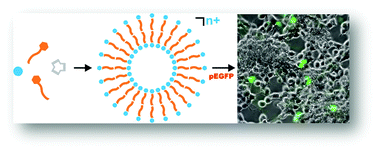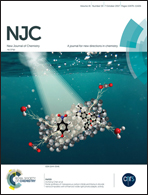Self-assembly of a novel Cu(ii) coordination complex forms metallo-vesicles that are able to transfect mammalian cells†
Abstract
Herein, we report the synthesis of amphiphilic bis-(4-pyridylmethyl hexadecanoate)-(1,4,7-triazacyclononane) copper(II) triflate, referred to as Complex 1, which forms metallo-vesicles in water by exploiting the principles of supramolecular chemistry. Extruded metallo-vesicles showed an average particle size of about 33 nm, which was revealed by transmission electron microscopy. The 50% cytotoxic concentration (CC50) of Complex 1 was determined to be 1.25 mM in human embryonic kidney cells (HEK 293-T), and through flow cytometry, it was revealed that these metallo-vesicles could deliver a reporter gene pEGFPN1 to HEK 293-T cells measured. In addition, a non-amphiphilic structural analog, namely bipyridine-(1,4,7-triazacyclononane) copper(II) triflate, hereafter called Complex 2, was synthesized and characterized by X-ray crystallography to reveal the coordination sphere around the copper(II) ion in Complex 1. This study suggests that transition metal-mediated self-assembly can be employed to form low-cost complex nanoparticles having low toxicity and gene transfection properties.



 Please wait while we load your content...
Please wait while we load your content...